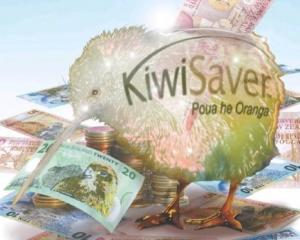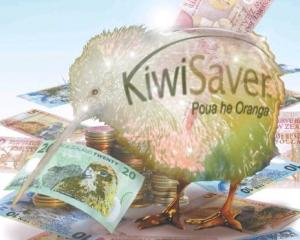
KiwiSaver turned 4 on Friday but birthday celebrations were kept low key. Despite accumulating $8 billion in savings, KiwiSaver, like other superannuation schemes before it, has become a political football. Business editor Dene Mackenzie reports.
The Government, in its May Budget 2011, changed the rules for KiwiSaver and Labour leader Phil Goff took advantage of those changes to take a swipe at Prime Minister John Key.
From Friday, the member tax credit paid by the Government into each KiwiSaver account to boost savings was cut by 50%.
"National's latest broken promise takes $2 billion out of the pockets of Kiwi mums and dads over the next four years, budget documents show, and forces them to dig deeper if they want to keep up their savings.
"That's some birthday present from John Key on the day the hugely successful KiwiSaver savings scheme turns 4," Mr Goff fumed.
However, Dunedin financial adviser Peter Smith said despite the budget reducing the tax incentive, KiwiSaver was still a good scheme because it was locked into "retiring age", whenever that might be. Currently, it was 65.
KiwiSaver provided a good base for New Zealand's infrastructure where there was an emerging problem for fund providers to find somewhere to place an ever-increasing inflow of funds.
"As stated in the Budget, the Government expects there to be $25 billion in 2015. There is currently $8 billion invested in only four years."
A new raft of investments would be opening up for fund managers and Mr Smith suggested the Government look at having joint ventures on infrastructure with KiwiSaver investments.
Already, there was scope for KiwiSaver fund managers to invest in the Canterbury rebuild.
Forsyth Barr savings specialist Damian Foster (27) said KiwiSaver was now established as the retirement savings platform for more than 1.7 million New Zealanders but he believed more changes were on the way.
He predicted that KiwiSaver would eventually become compulsory for all employees aged between 18 and 65.
Once funds reached a certain level, individuals might start taking more active control of their accounts, similar to the "self-managed" superannuation which was popular in Australia.
Minimum contributions were likely to rise from 3%, Mr Foster said.
One of the main things he would like to see introduced was the ability of students to pay off their student loans using KiwiSaver.
"I have found many young people join KiwiSaver, but avoid making serious contributions unless they are saving for a home deposit.
"Having a student loan withdrawal also appeals for younger families where parents and grandparents can contribute to the account on special occasions, knowing the funds are locked away to pay for tertiary education."
The other two things Mr Foster would like to see introduced was KiwiSaver becoming compulsory and agreement between the major political parties not to tinker with the scheme.
The agreement among politicians would stop KiwiSaver becoming a political football and help give New Zealanders the confidence to rely on what had already become an $8 billion savings platform.
With younger savers likely to amass KiwiSaver balances in the hundreds of thousands of dollars, the discrepancy between those who saved and those who did not was too great to ignore.
"It's potentially only a matter of time before we follow Australia's lead, requiring all employees to be part of a workplace superannuation scheme. In most cases, this will be KiwiSaver," Mr Foster said.
Mr Smith said that from April 1, 2013, the employers' contribution to KiwiSaver would rise to 3% and it was suggested that the employee contribution should also rise to 3% with 3% becoming the default.
"In my opinion, the change to a 3% contribution will hardly be noticeable. In reality, the amount is very small and is also not enough to give a satisfactory lump sum in retirement."
The Government's own examples of savings after the changes proved that, he said.
A working couple aged 35 with a combined gross income of $77,000 were expected at age 65 to have saved $247,500. While that was a good sum in today's dollars, New Zealand Superannuation was about $120 to $140 a week short for a married couple - the equivalent generated from a lump sum of about $460,000.
The Government's example suggested that New Zealand Super would also be available in the future but there were doubts about whether the combined total would be enough to live on, Mr Smith said.
Australia had already found that contributions since 1994, initially at 3% and rising to 9% by 2002, were not adequate and they were being increased to 12% of the gross wage.
"It is obvious we must save more."
Mr Smith predicted smaller fund managers would morph into larger providers.
The Morningstar KiwiSaver performance survey of March 31 listed 17 providers on 132 individual funds. That included Huljich with three funds which had since been absorbed into Fisher funds.
It was noted that Gareth Morgan Funds were not included in the survey.
In April 2010, Asteron transferred its KiwiSaver funds of $33 million to Grosvenor.
In March, there were five providers with less than $30 million under management.
WHAT HAS CHANGED
• Minimum contribution rates have gone from 4% to 2% and will soon be back up to 3%.
• Government contributions have dropped from $1043 a year to $521 a year.
• Government removed the annual $40 fee subsidy and the tax credit for employers.
• A proposal to introduce standard guidelines for how each KiwiSaver provider discloses its fees and fund returns to enable easy comparison.






